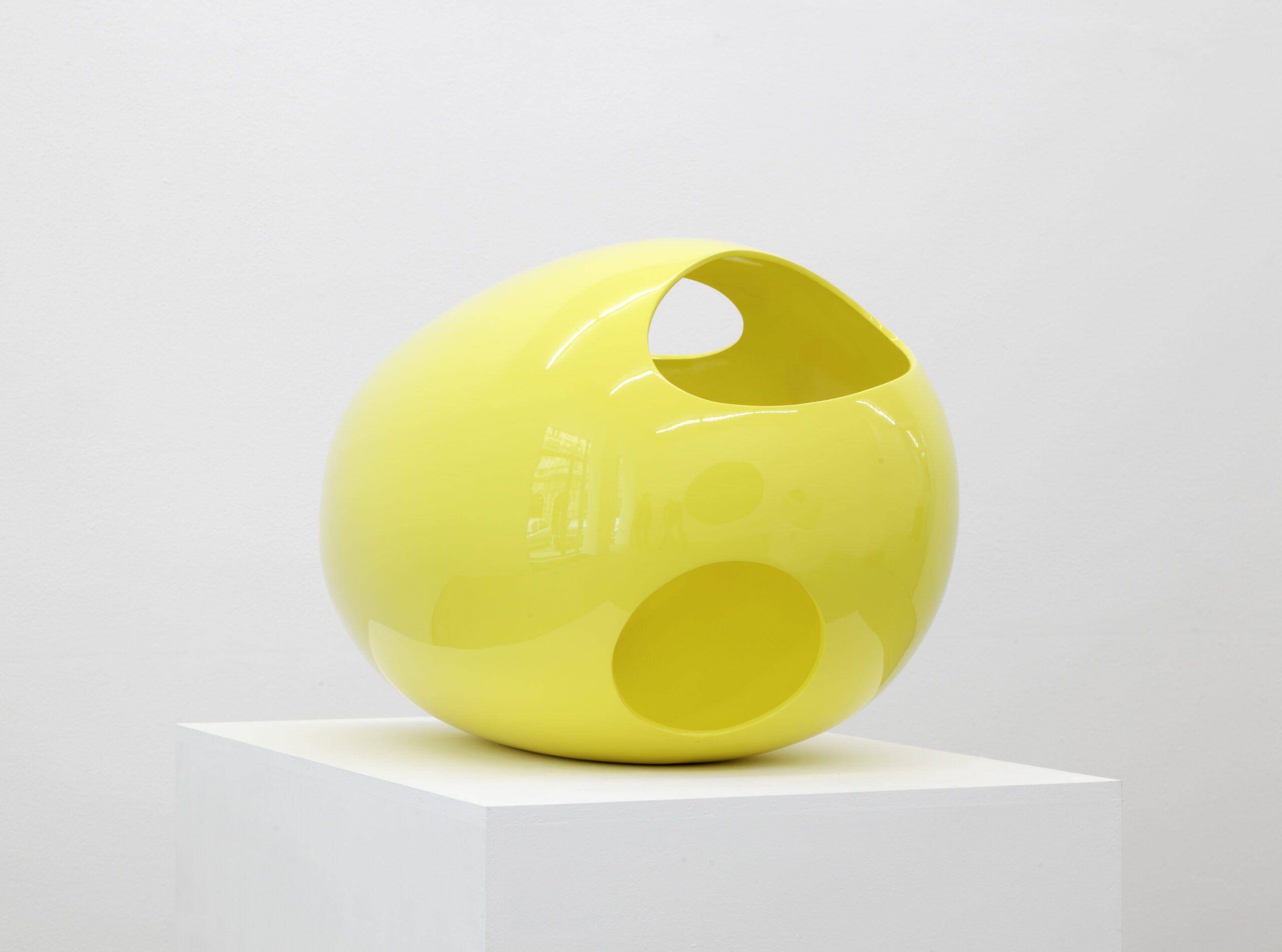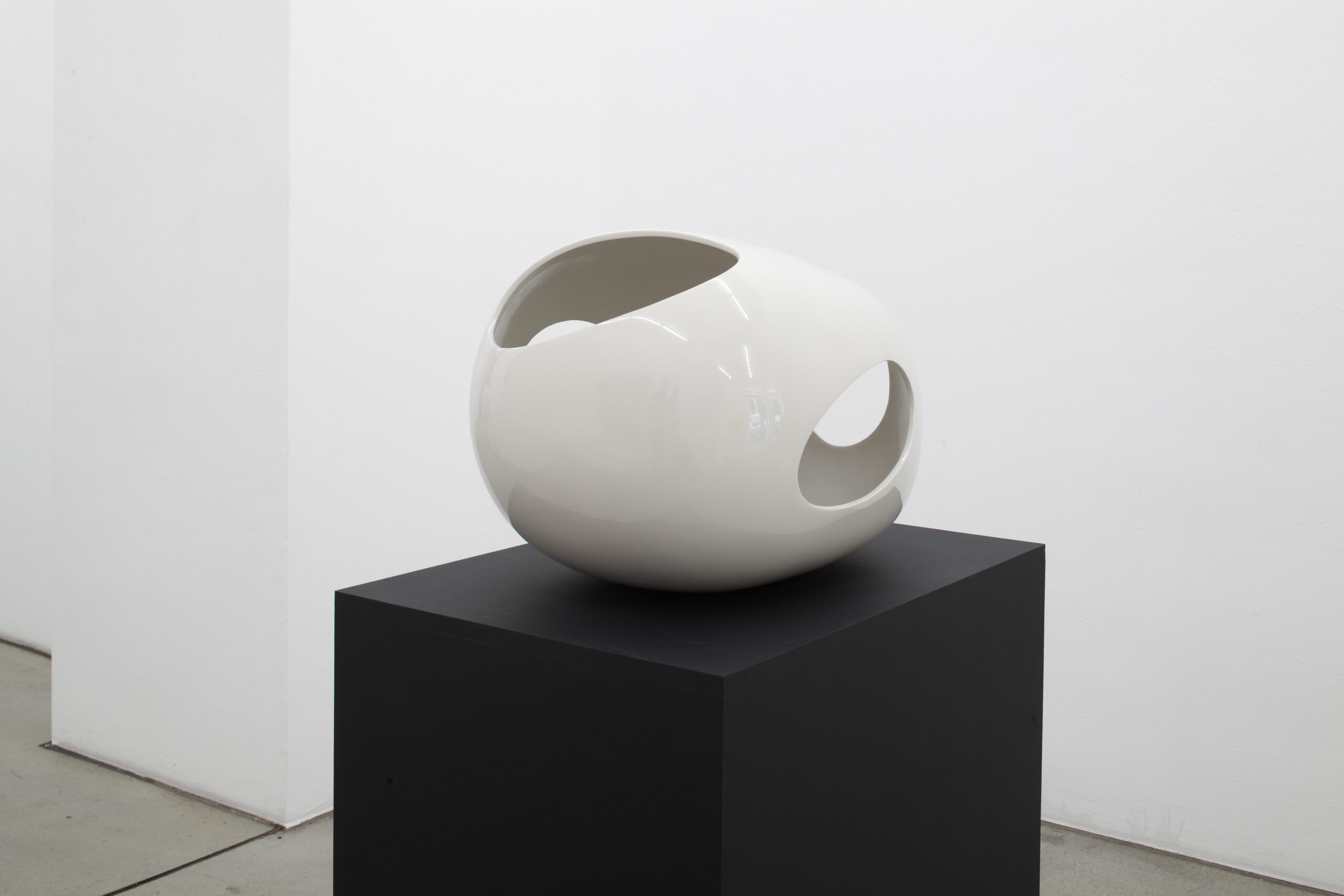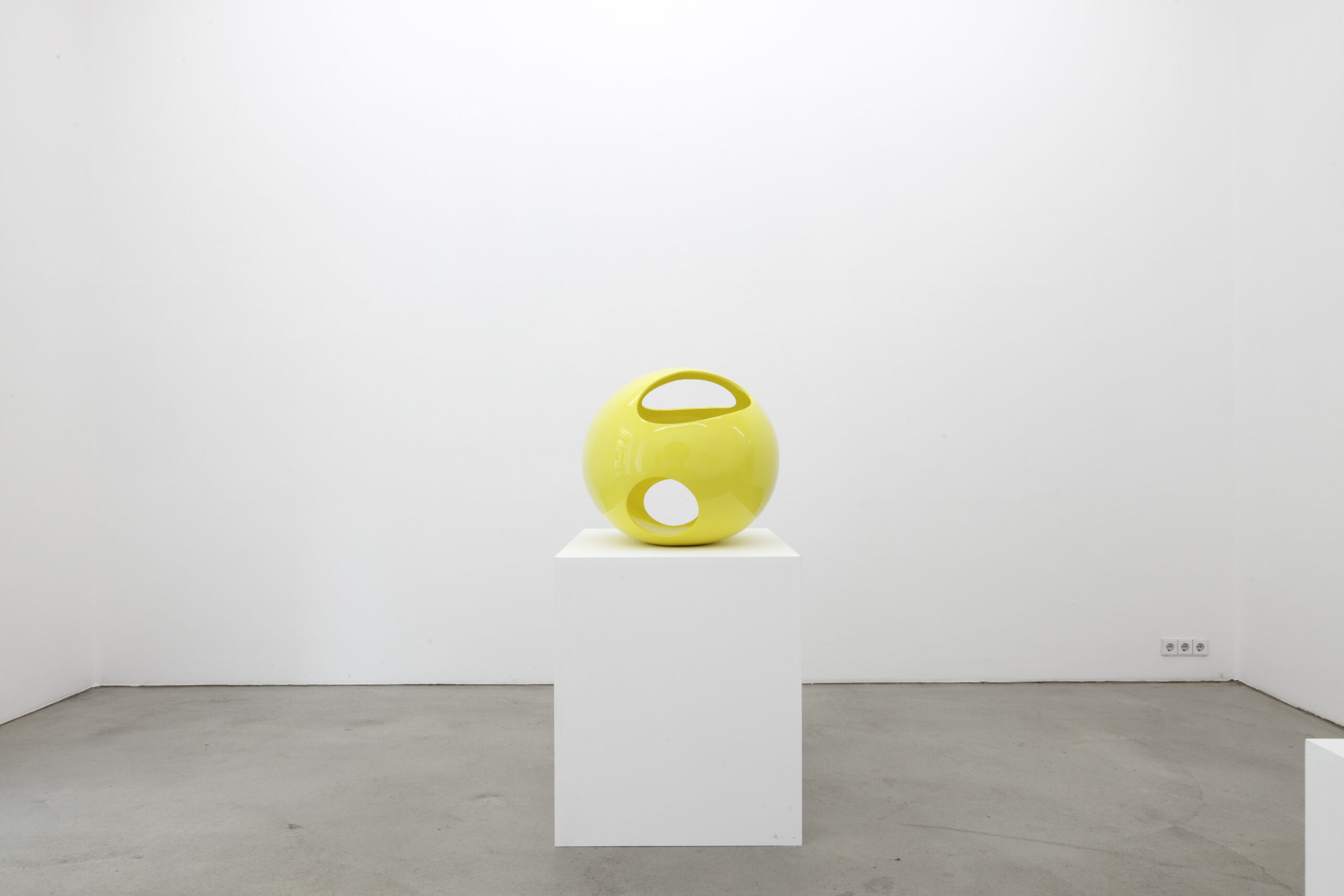
Es ist eine reduzierte, konzentrierte Farbskala von Lemongelb, Pepperwhite, Rosa, Schwarz und Silber auf die wir in den drei neuen Werkgruppen „Ohne Titel“ von Barbara Mungenast treffen. Ein entscheidender Akzent im Ausstellungsdisplay wird auf den präsenz-ästhetischen Austausch zwischen den dynamischen, raumgreifenden kunst-, architektur- und designgeschichtliche Bezüge reflektierenden Aluminiumskulpturen und den ovalen Formvariationen der Bildserie „Ohne Titel“ gelegt. Ergänzt wird das Setting durch eine spiralenförmige Lichtskulptur am Galerie-Desk und einer Gegenüberstellung von Spiralenformationen auf kreisrunden „Shaped Canvas“ im Präsentationsraum der Galerie im Untergeschoss. Im Ausstellungs-Setting gelangen die Werke durch die Inszenierung von Blickachsen in einen geradezu szenischen Zusammenhang zur Architektur und werden durch die Präsentation der Skulpturen auf weißen und schwarzen Sockeln dramaturgisch in einen diskursiven Rahmen gespannt.
Die von Barbara Mungenast eigens entwickelte Methode den Malprozess nicht direkt auf der Leinwand, sondern auf über den Boden ausgebreiteten Plastikfolien auszuführen, findet sich auch in ihren neuen Bildserien wieder und befreit sie vom malerischen Figur/Grund Dilemma. Die Entstehung der Form aus der Fläche und die Beziehung zwischen Form und Grund – jene Prämissen aus welchen die abstrakte Malerei ihre Legitimation zog, werden so aufgebrochen. Die weißen rechteckigen oder kreisrunden Leinwände als Bildträger kommen erst danach ins Spiel, indem die in mehreren Schichten gemalten ovalen Formen oder durch Röhren aufgetragenen Spiralen als Negativformation darauf montiert werden. Die metonymische Funktion der Leinwand als Bildfläche erfährt infolgedessen ebenfalls eine Umkehrung. Durch diese gleichzeitige Isolation des Farbauftrags oder des Pinselstriches von der Leinwand begibt sich Barbara Mungenast in einen Post-Essentialismus der Malerei.
Anders als Maler der klassischen Moderne wie beispielsweise Mondrian versucht Barbara Mungenast nicht, den Gegensatz zwischen Form und Untergrund aufzuheben, sondern eignet sich gerade diese Dialektik als gestalterische, plastische Äquivalenz an. Ihre Strategie richtet sich nicht gegen ein gestisches oder abstraktes Malereimodell, sondern explizit gegen dessen Suggestivität, dass sich daraus die eigentliche Bedeutung ableitet. Die Künstlerin befindet sich nicht auf der Suche nach der „reinen“ Form, sondern erforscht in ihren aktuellen Serien radikal und aggressiv deren provokatorisches Gegenteil einer „Unform“ auf ihre ästhetischen Qualitäten.
Die monochromen schwarzen, perlmuttweißen oder rosa Oval-Variationen auf weißer Leinwand, zeigen einen Pop-Appeal, deren ovale Formen gleichzeitig als malerische Handlung rituelle Abwandlungen und Abweichungen durchlaufen. Hier wird der subjektive Farbauftrag offensiv gegen das minimalistische Diktum einer „Objektivierung des Malvorgangs“ wie Benjamin H.D. Buchloh es beschrieb, eingesetzt. Die Proportionen der Ovale und wie sie sich zur Leinwand verhalten, bilden die Rahmenhandlungen der relationalen Bezüge jedes Bildes, die es zu entgrenzen gilt. Genau in dieser Umkehrung der Verhältnisse von Bildträger und Form äußert sich das, was Jacques Derrida als Kontrastsignatur bezeichnete. Die ovale Form wird nicht zu einem programmatischen Icon oder zum Symbol einer strengen Symmetrie, sondern zeigt Parallelen zu einer exzentrischen Abstraktion wie sie die amerikanische Kritikerin und Kuratorin Lucy R. Lippard postulierte. Radikal operiert Barbara Mungenast zwischen den Rändern und dem Zentrum formalistischer sowie antiformalistischer Spannungsprozesse. Manuell, wie intellektuell und konzeptuell werden im Prozess Programmatiken einer ästhetischen „correctness“ hinterfragt.
Die von Barbara Mungenast entwickelte haptische Qualität ihrer Malerei findet eine logische Fortsetzung in ihrer neu produzierten Skulpturenserie „Ohne Titel“. Die eiförmigen und ovalen Strukturen der Skulpturen bilden allerdings nicht die Konsistenz formaler Einscheidungsprozesse, sondern den Ausgangspunkt für eine Dynamisierung durch ellipsenartige Einschnitte. Die so erzeugten Linien durch den Raum verweisen auf Topologien, die darin enthaltenen visuellen, räumlichen, zeitlichen Schnitte entsprechen der Funktion von Einschnitten in unsere reale Erfahrung. Die Design-Utopien der Moderne, die sich in einem Vordringen in die Gestaltung von Lebenswelten äußerten, dringen hier unter umgekehrten Vorzeichen in den künstlerischen Gestaltungsprozess ein. Dynamische Kurven entstehen, deren Formkonstellationen uns einladen, den geometrischen und ästhetischen Schlüssel dieser auratischen Dekomposition zu entdecken. Die chromatischen Qualitäten der verwendeten industriellen Autolacke überziehen als kontinuierliche Oberflächen das Innere und Äußere der Aluminiumskulptur. Der skulpturale Topos gerät hier in Verbindung mit dem Malerischen, wie wir es aus Werken von Lynda Benglis kennen. In ihrer Verwendung industrieller Materialien wie Autolacken zeigen die Werke von Barbara Mungenast Merkmale der minimalistischen Skulptur, allerdings werden sie nicht maschinell, sondern im künstlerischen Prozess handwerklich produziert. Außerdem entfernt sich Barbara Mungenast durch ihre radikal eingesetzten Irregularitäten wiederum von der minimalistischen, Juddschen oder jeder anderen Form eines angestrebten Produktionsperfektionismus um seiner selbst willen und befindet sich hier näher an der analytischen methodischen Dynamik einer Bridget Riley. Skulptural verfährt Mungenast in der Umsetzung direkt, sogar brutal wie sich in den scharfen Kanten der Konturen zeigt und doch gleichzeitig zurückgenommen, singulär. So wie das Objekt durch unsere Wahrnehmungen hindurchgeht, so nisten sich umgekehrt diese wiederum in das Objekt ein. Wir denken an Blinky Palermo, wenn wir sehen, wie Barbara Mungenast durch Verfahren der formalen Reduktion, die materielle Substanzialität der Farbe und Spuren des Gestischen an die Stelle des industriellen Looks minimalistischer Prototypen treten lässt. Daraus resultiert eine Anspannung und Direktheit, die unsere Wahrnehmung unmittelbar auf eine radikale Weise herausfordert und aktiviert.
Monochrome silberne oder weiße Farbspiralen auf kreisförmigen Leinwänden, deren haptische Oberflächestrukturen reliefartige Wirkung zeigen, befinden sich im Showroom der Galerie. Die gestische Malerei verläuft hier unter kontrollierten Bahnen durch den Einsatz von speziellen, röhrenförmigen Vorrichtungen des Farbauftrages, gerät zu einer Mischung zwischen manuellem und apparaturhaftem Auftrag. Dieser erfolgt ebenfalls nicht direkt auf der Leinwand, sondern auf Plastikfolien. Um Schlieren, Spritzer oder Tropfen zu vermeiden, benötigt die Farbe eine spezielle Konsistenz. In ihrer Übertragung als bildimmanente Orientierung wirft Barbara Mungenast die Frage auf, wie sich diese den All-over-Techniken von Jackson Pollock anverwandten Drehungen, Verkehrungen und spiralenartiger Strudel auf den Betrachter auswirken. Die malerische Performance durch die Rotation lässt die Geste durch das Loslösen der spiralenartig rotierenden Acrylstränge zu einem Lassoschwingen werden. Auch in den Liniensträngen der Kreisbilder erzeugt Barbara Mungenast einen reziproken Gegenlauf, dessen hypnotische Wirkung den Blick einsaugt. In einer skulpturalen Immaterialität taucht die Spiralenformation als Lichtskulptur nochmals auf.

Barbara Mungenast
Ohne Titel, 2009
Aluminium, Autolack
90 x 70 x 58 cm
Here we see three new groups of work: “Ohne Titel” by Barbara Mungenast – reduced, concentrated colour spectra of lemon-yellow, pepper-white, pink, black and silver.
The exhibition has been given a definite, decisive feeling by the contemporary aesthetic exchange between dynamic attention-seizing art/architecture and design and history influenced aluminium sculptures. The scene is completed by a light sculpture in form of a spiral at the Gallery desk and the “confrontation” of spiral formations on the circular “Shaped Canvas” in the basement Gallery presentation room.
The works benefit from an architecturally coherent staging of visual planes and, by being presented on white and black bases, the works leave us fascinated by the dramatic and discursive artistic framework.
Through developing her own creative processes, working not directly onto the canvas but onto plastic foils spread out above the floor, Barbara Mungenast ‘rediscovers’ herself through her new series of works and frees herself from the “subject-ground” dilemma.
The creation of forms from the plane, and the relationship between forms and the ground – the premises from which abstract art takes legitimacy are thus refuted. The white circular or rectangular canvases first come into play, by creating oval forms from several stacks or as tubes and ordered spirals creating inverted shapes. The metonymic function of the canvas as an ‘image plane’ likewise experiences a reversal. By the simultaneous isolation of colour ordering and the brush-lines of the canvas, Barbara Mungenast enters the realms of post-existentialist art.
In contrast to classical modern painters such as Mondrian, Barbara Mungenast does not try to waive the contrast between form and background, rather she views this discourse more suitably as formative, as a plastic equivalence. Her strategy is not directed against the abstract painting model per se, but explicitly against the suggestion that actual meaning is derived from this. The artist is not in the search for „the pure“ form, but rather in her current series of works. decided to investigate radically and aggressively, the provocative opposite of aesthetic qualities: „Unform “.
The monochrome black, mother of pearl white and pink oval variations on the white canvas have popular appeal, yet at the same time the oval forms are subject to deliberate artistic acts of ritual modification and deviation.
The subjective colour order here becomes “offensive” if we compare it to the minimalistic concept of „objectification of the artistic procedure “ as championed by Benjamin H.D. Buchloh.
The proportions of the ovals and other influences on the canvas, form the framework of the relational reference of each picture and succeed in containing the work. It is precisely this reversal of “image-bearer” conditions and form that Jacques Derrida describes as ‘signature contrast’. The oval form does not become a prescriptive icon or the symbol of a strict symmetry, but shows parallels to eccentric abstraction, as postulated by the American critic and curator Lucy R. Lippard.
Barbara Mungenast operates radically between the edges and the center of exciting formalistic as well as anti-formalistic processes. Aesthetic „correctness “ is manually, intellectually and conceptually analyzed during the artistic process.
The struggle by Barbara Mungenast to develop the quality of her work finds a logical continuation in the new series of sculptures „Ohne Titel“. The egg-shaped and oval structures of the sculptures do not form formal divisions in the works but are the starting point for a new dynamic – achieved through ellipse-like cuts in the structures. Areas created by the various forms refer to topologies, the visual, spatial, temporal cuts contained in it correspond to cutting into our material experience.
Modern design ideals, which usually seem alien in normal life environments, enter here under abstract means into the accepted artistic organizational process.
Dynamic curves develop, whose forms create constellations that invite the spectator to discover the geometrical and aesthetic key in order to “de-compose” the work. The chromatic qualities of the industrial car lacquers used to cover the continuous surfaces inside and on the exterior of the aluminum sculpture are exceptionally pleasing on the eye. The sculptural topology can here be compared to the pictoral works of Lynda Benglis.
In the use of industrial materials such as lacquers, the works of Barbara Mungenast have many of the characteristics of industrial, minimalistic sculpture, however the finish is here hand-produced during the artistic process rather than by machine. Barbara Mungenast also separates her work from the minimalistic and every other form of “production perfectionism” by introducing radically employed irregularities, often approaching the analytical methodical dynamic of Bridget Riley.
Mungenast uses direct sculptural processes, often brutally, illustrated by the sharp edges of the outlines yet she is nevertheless at the same time restrained, individual. We perceive transitory forms that then contort and reintegrate themselves into the object as a whole.
Barbara Mungenast, through her unique “minimilisation” processes, allows the substantiality of colour and feeling to permeate through, instead of producing industrial looking prototypes (reminiscent of Blinky Palermo). From this results conflict – and a directness, both of which radically provoke and stimulate our perceptions.
In the Gallery showroom hang monochrome silver or white colour spirals on circular canvases, whose surface structures are textured with a relief-like effect.
Barbara Mungenast has here used controlled and precise production methods, using special tubular devices which are used to control colour order: the artist combining manual and mechanical means. As before the paint is not applied directly on the canvas, rather on to plastic foils.
In order to avoid streaks, splashes or drops, the colour medium requires a special consistency. Barbara Mungenast’s application methods here echo the techniques of Jackson Pollock; each reversal and spiral-like vortice having dramatic effects on the spectator.
The rotation method creates spiral-like rotating acrylic strands forming a detached “lasso” of colour. The lines Barbara Mungenast produces also show a counter-movement, whose hypnotic effect dizzies the spectator. In sculptural materialism, the spiral formation emerges again as light sculpture.







